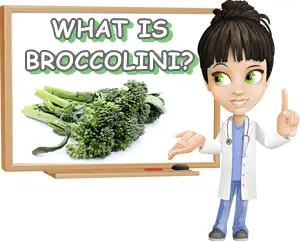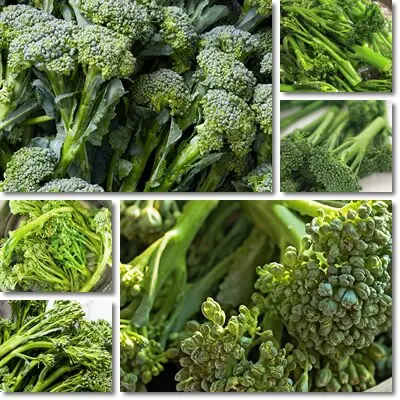Have you ever had broccolini? You may know broccolini as baby broccoli due to its rather striking resemblance to broccoli.
But is broccolini the same thing as broccoli? Is broccolini really a baby broccoli variety? What is broccolini more exactly and where does it come from?
What is broccolini?
Broccolini is a botanical and culinary vegetable. It’s a cruciferous vegetable in the cabbage family.
That makes broccolini related to cabbage and, of course, broccoli, but also gai lan or kai lan (Chinese broccoli or Chinese kale), kale, collards, cauliflower, mustard, horseradish and radishes, among other vegetables.

The name ‘broccolini’ is actually a plural, judging by the origin of the word. The name is a derivative of the word ‘broccoli’ which is actually Italian in origin and also a plural form. The singular for ‘broccoli’ in Italian is ‘broccolo’ which would make the singular form for ‘broccolini’ something like ‘broccolino’. Nevertheless, both broccoli and broccolini are used in the singular in English.
Where does broccolini come from?
Broccolini is actually not naturally occurring, but the product of intentional hybridization.
In the 1990s, a Japanese seed company began crossing broccoli and gai lan or kai lan, better known as Chinese broccoli – the result was the vegetable now known as ‘broccolini’.
So broccolini is a cross between broccoli (Brassica oleracea var. italica) and Chinese broccoli (Brassica oleracea var. alboglabra).
Also see the benefits of broccolini for health.
Broccolini is a registered trademark, registered with the United States Patent and Trademark Office since Jul. 11, 2000 (see patent).
The rights for growing and commercializing broccolini are owned by the Japanese Sakata Seed company in partnership with the American Mann Packing Company.
And for some interesting facts: initially, broccolini was sold under different names – Asparation and Aspabroc.
The original names hinted at the resemblance with asparagus, that is, the long, slender, green stalks that look like asparagus stalks. Broccolini was adopted later and has stuck with consumers.

Is broccolini GMO?
No, broccolini is not GMO. In fact, broccolini is not genetically modified in any way. It’s actually the product of classic plant breeding – two closely related vegetable species from the same botanical family, broccoli and Chinese broccoli, were crossed to create a new vegetable.
What does broccolini look like?
Broccolini looks like both broccoli and asparagus: green, with long, asparagus-like stalks and looser, broccoli-like florets on top.
The stalks are relatively slender, usually lighter green compared to the florets, with some knobs here and there. The florets are a deeper, darker green, similar to those of broccoli, but looser set. Several florets branch out from each stalk.
Broccolini also looks like a thinner, longer, apparently younger version of broccoli, hence the names ‘broccolini’ and ‘baby broccoli’ both of which directly reference a smaller/younger broccoli.
Broccolini also looks a lot like sprouting broccoli, especially after it’s been cleaned of leaves to be made ready for consumption.
There is also a purple broccolini variety which is the exact same vegetable, except that it’s greenish-purple, similar to purple asparagus.
Compared to regular, green broccolini, purple broccolini has the added benefit of having purple anthocyanin antioxidants which studies have shown are a source of free radical scavenging, anti-inflammatory, reparative and antitumor properties.
What does broccolini taste like?
Broccolini tastes like broccoli, but its flavor profile is much more pleasant. The taste of broccolini can be described as a mix of mild bitter flavors complimented by sweet flavor notes.
There is also a broccoli or asparagus like aroma profile to broccolini which is more pregnant in the raw vegetable.
You can eat broccolini both raw and cooked. Cooked broccolini is sweeter, more mellow; if it’s not overcooked, it retains a slight crispness all the while having a soft consistency.
Raw broccolini is quite crisp and more cabbage-like in taste, and also more bitter. Old stalks can be quite tough and less suitable for consumption raw as a result.
Broccolini stalks, leaves and florets (flower heads) with flowers are all edible and perfectly safe to eat. While you can eat broccolini at different growing stages, both raw and cooked, just like broccoli, it is best consumed before it flowers. The younger the broccolini, the more tender and sweet it is and the more palatable the experience.
Is broccolini a variety of broccoli?
Yes and no. Yes, broccolini is a variety of broccoli in the sense that it’s a cross between broccoli and another vegetable, in other words it’s derived from broccoli. And no, it isn’t a variety of broccoli because it’s not actually 100% broccoli, but only part (half?) broccoli.
Is broccolini the same thing as baby broccoli?
If you’ve ever had the chance to buy or eat broccolini, then you’ve likely heard it being called ‘baby broccoli’.
Baby broccoli is a common name used to denominate broccolini in English, and due to its extensive use it’s come to be a synonym for broccolini.
But botanically speaking, broccolini and baby broccoli are not the same thing.
There’s actually a vegetable called ‘baby broccoli’ – that vegetable is broccoli. Just like baby spinach is a much younger version of spinach, so is baby broccoli a much younger version of broccoli.
And broccoli and broccolini are not the same thing which makes baby broccoli and broccolini also not the same thing.
When is broccolini in season?
Cabbage family vegetables are naturally cold season vegetables. And broccolini being a mix of broccoli and Chinese broccoli (gai lan / kai lan), both cabbage family cold season vegetables, that makes it a cold season vegetable too.
It’s in season late fall through winter and most of spring too. It is available in limited amounts throughout the year as well, outside of its season, its cultivation being possible due to the seasons being reversed in the two hemispheres.
